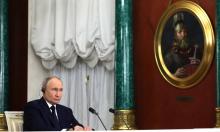Experts study Turner's paintings to track climate change
A group of scientists has studied the vivid sunsets painted by J.M.W. Turner, believing that they can help to track climate change.

Greek scientists have studied the colors in more than 500 paintings of sunsets, including many of Turner's 19th century watercolors and oils, in hopes of gaining insights into the cooling effects caused by major volcanic eruptions.
By better understanding past changes in climate, they hope to improve computer models for future climate change.
Christos Zerefos, who led the research at the National Observatory in Athens, said he believed it was the first scientific study of art for clues to past climate variations.
"The initial idea arose from the fact that we saw an increased reddening of colors in sunsets which followed large volcanic eruptions, particularly Krakatoa," Zerefos said.
The scientists studied works painted around the times of major volcanic eruptions, such as the cataclysmic eruption of Indonesia's Mount Krakatoa in 1883, to measure how much natural pollution those eruptions pumped into the skies.
Accounts from the time describe brilliant skies as the setting sun's rays were scattered through reflective dust and ash particles.
By measuring the relative amount of red and green in the paintings, the scientists aimed to calculate the amount of dust in the atmosphere. The greater the pollution, the redder the sunset, Zerefos said.
But Kevin Trenberth, who heads the Climate Analysis Research Center at the National Center for Atmospheric Research in Boulder, Colorado, and who is not connected to the study, warned that artists and scientists do not necessarily approach sunsets the same way.
"Painters are not scientists trying to do an accurate picture of nature," he said. "They are artists trying to make something look good or dramatic. A scope for embellishment presumably comes in."
And James Hamilton, the curator at the University of Birmingham who has written several books on Turner, said that while Turner had claimed to paint what he saw, it's dangerous to put too much weight on an artist's interpretations at any one time.
"They (artists) are not making absolutely clear and accurate records of what they can see," he said.
"In many cases they are just working with that imagination as well, and it's very hard to tell when artists are being absolutely accurate and when they're using vivid sky as a platform to more vivid painting."
Scientists have long thought that major volcanic eruptions contribute to a process called global dimming, where air pollution dust and ash from natural and industrial sources block the sun and have a cooling effect.
Some scientists believe that as pollution from industry is cleared, global warming could speed up.
Turner was particularly important in the study because he was alive during three eruptions, including the so-called "year without summer" after the eruption of Mount Tambora, Indonesia in 1815, which spewed out so much dust and ash that it caused widespread famine. The other two eruptions were of the Babuyan Claro volcano in the Philippines in 1831 and the Cosiguina volcano in Nicaragua in 1835.
Zerefos said his group was taking advantage of these artists' penchant to paint nature as they saw it. Turner, for example, once said he "wished to show what such a scene was like."
"They all may have different way of painting, but the colors they used were representing the real environment." Zerefos said. "I was surprised to see that independent of the school or of the artist, a coherent picture is emerging slowly."
Paintings of skies have been used to study weather and atmosphere in the past, using Claude Monet's London series to look at pollution in the Industrial Revolution and Vincent Van Gogh's stars to study the night sky, said John Thorne, a professor of atmospheric meteorology at the University of Birmingham, who is not connected to the study.
But Thorne pointed out that while there can be a worry about painters using artistic license, the study seems to average the possibility of artistic interpretation by using such a large cross section of artists.
"Some artists are very true to nature, some are very true to making up their own story. You have to understand the artist," Thorne said. "But they've used a huge cross section. So rather than a specific artist, they're more showing an average across all artists, and have showed that they are in fact subconsciously depicting what they see without necessarily realizing it."
Hamilton agreed, noting: "the more artists and more known dates, the better."
The group obtained images of 554 paintings from 181 artists, including Edgar Degas, Gustav Klimt, Rembrandt, Thomas Gainsborough and Peter Paul Rubens. They then narrowed it down five artists, such as Turner, who were painting before, during and after the time of volcanic eruptions.
Computers were used to digitally measure the red-green ratio. Of the 54 paintings from times of volcanic eruptions, every case showed a significant reddening or pollution of the sky.
In the study, published in the journal Atmospheric Chemistry and Physics, Zerefos and his researchers wrote that the reddening of the paintings "can be tentatively attributed to the volcanic events and not to abnormalities in the color degradation due to age or other random factor."
The writers point out that their results are supported by independent historical accounts and other evidence such as measurements of dust particles trapped in ice cores.
Subscribe to Pravda.Ru Telegram channel, Facebook, RSS!





